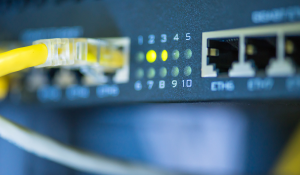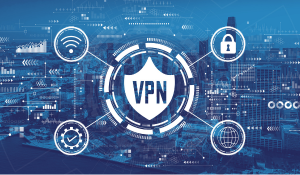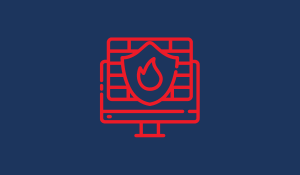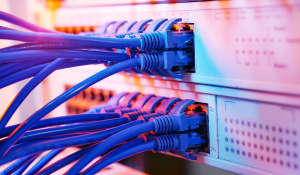The importance of VPNs for secure business
One of the key technologies that plays a decisive role in this is the Virtual Private Network (VPN). VPNs have become an indispensable tool in...
4 min read
 DriveLock
Mar 13, 2025 9:39:57 AM
DriveLock
Mar 13, 2025 9:39:57 AM

An IP address is the cornerstone of digital communication in any working environment and serves as a unique identifier for devices connected to a network. However, this important component can become a double-edged sword if it falls into the wrong hands. Cybercriminals can exploit an IP address to carry out sophisticated attacks ranging from network breaches to data theft.
| CONTENT |
Find out more details about potential cyber threats from an unprotected IP address and the importance of robust security measures to protect your workplace.
An IP address, short for Internet Protocol address, is a unique identifier assigned to any device connected to a network. It works like a digital address and allows devices such as computers, smartphones and servers to communicate with each other over the internet. An IP address is essential for sending and receiving data, much like a postal address enables the delivery of letters.
There are two types of IP address formats: IPv4, which consists of strings of numbers separated by dots (e.g. 192.168.0.1), and IPv6, a more modern and complex format designed for the growing number of devices on the internet. Knowing your IP address can help you troubleshoot network problems, improve cybersecurity and effectively manage online privacy.
The role of an IP address in online communication is fundamental but often overlooked. It serves as a unique digital identifier and facilitates the smooth exchange of information between devices across networks. The following explains the essential steps of how an IP address works to enable this connectivity.
Address assignment: A device receives an IP address either dynamically via DHCP (Dynamic Host Configuration Protocol) or statically if it is manually configured.
Initiating a request: When a user attempts to access a resource online, the device sends a request with its IP address for identification.
DNS resolution: The Domain Name System (DNS) converts the human-readable domain name (e.g. example.com) into the IP address of the server, ensuring that the request reaches the correct destination.
Pathfinding: Routers use the IP address to direct the data request to the server via the fastest and most efficient route on the network.
Data transmission: The server sends back the requested information and addresses the response to the IP address of the device.
User access: The device receives the data packets, reassembles them and displays the requested content to the user.
An IP address is a fundamental part of any workplace's digital infrastructure and enables seamless communication and data exchange. However, if it is unprotected or improperly secured, it can become a gateway for cybercriminals to exploit vulnerabilities in your organization's network. Understanding the various cyber threats associated with an IP address is critical to protecting sensitive company data and maintaining a secure work environment.
Cybercriminals can use an unprotected IP address to identify and exploit vulnerabilities in your organization's network. They can gain unauthorized access to sensitive systems or data through brute force attacks or scanning for open ports.
With access to your IP address, attackers can launch a DDoS attack and overload your company's servers with excessive traffic. This can lead to system downtime, business interruption and financial loss.
By tracking the geographic location associated with an IP address, hackers can tailor phishing campaigns to specific employees or offices. These highly targeted attacks increase the likelihood of success in stealing login credentials or infecting devices with malware.
Hackers can use your IP address to impersonate your company in fraudulent activities. This can include sending phishing emails to customers or partners that appear to come from a trusted company source.
An unprotected IP address can be exploited to intercept data being exchanged between devices in the workplace. Cybercriminals can intercept sensitive communications, login credentials or confidential files by interposing themselves between the user and the server.
Once an attacker has gained access to your network via an IP address, they can move laterally to extract sensitive data such as intellectual property, customer information or internal documents.
Many workplaces rely on IoT (Internet of Things) devices such as smart cameras or printers. If these devices are poorly secured, an unprotected IP address can allow attackers to take control, disrupt operations or use them as entry points into the wider corporate network.
Vulnerabilities associated with the IP address can allow attackers to infiltrate your network and deploy ransomware. This can encrypt important files and bring business operations to a standstill until a ransom is paid.
Because IP addresses act as digital identifiers, they are often the target of hackers trying to exploit vulnerabilities. Implementing effective security measures is crucial to minimize risks and ensure the safety of your work environment. Below are five practical tips on how to keep your company's IP addresses secure.
A VPN masks your IP address by redirecting your internet traffic through a secure server. This makes it harder for cybercriminals to identify and exploit your company's network and adds an important layer of privacy and security.
A robust firewall monitors and filters incoming and outgoing data traffic, preventing unauthorized access to your network. Securing open ports minimizes the risk of hackers exploiting your IP address to infiltrate your systems.
Use IP whitelisting to restrict access to critical systems and data. By only allowing authorized IP addresses to connect, companies can reduce the risk of cyberattacks from unauthorized sources.
Constantly monitor and analyze network traffic to detect unusual activity associated with your IP address. By detecting and responding to anomalies at an early stage, potential security breaches or attacks can be prevented.
Conduct regular training to raise awareness of the risks associated with sharing or disclosing an IP address. Employees should know the best practices for securing devices and networks and minimize human error that could lead to vulnerabilities.
The importance of a well-protected IP address in the work environment cannot be overemphasized. Without the right security measures in place, your IP address becomes an easy target for cybercriminals who can launch attacks in a variety of ways. By being aware of the threats and implementing proactive security measures, you can minimize many of these risks.
Protective measures for your IP address should be part of a comprehensive cybersecurity strategy that considers both technical and organizational security aspects.

One of the key technologies that plays a decisive role in this is the Virtual Private Network (VPN). VPNs have become an indispensable tool in...

Are you ready to fortify your digital defenses and safeguard your network from cyberattacks? Look no further than the network firewall. A formidable...

A proxy server acts as an intermediary between a client and a server. It allows clients to establish indirect network connections to other servers...